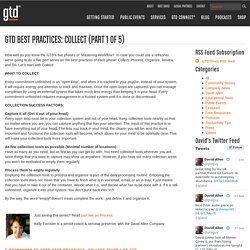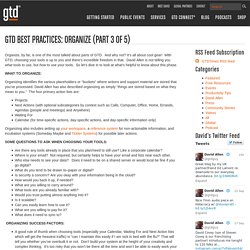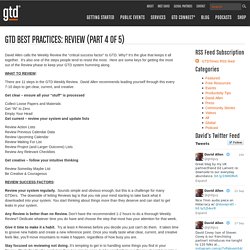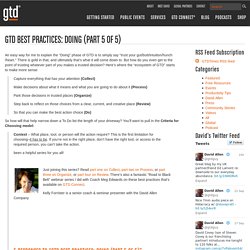

GTD Best Practices: Collect (Part 1 of 5) How well do you know the GTD’s five phases of Mastering Workflow?

In case you could use a refresher, we’re going to do a five part series on the best practices of each phase: Collect, Process, Organize, Review, and Do. Let’s start with Collect! Every commitment unfinished is an “open loop”; and when it is tracked in your psyche, instead of your system, it will require energy and attention to track and maintain. Once the open loops are captured, you can manage completion by using an external system that takes much less energy than keeping it in your head. Every commitment unfinished requires management in a trusted system until it is done or discontinued.
Capture it all (Get it out of your head) Every open loop must be in your collection system and out of your head. As few collection tools as possible (Minimal number of locations) Have as many as you need, but as few as you can get by with. By the way, the word “empty” doesn’t mean complete the work– just define it and organize it. GTD Best Practices: Process (Part 2 of 5) We’re continuing our series on the best practices of GTD’s five phases of Mastering Workflow: Collect, Process, Organize, Review, and Do.

Let’s look closer at the Process phase. Processing is the core fundamental thinking that defines the meaning of each item collected. Outcomes and next actions are determined for actionable items, and the non-actionable items are identified as trash, something potentially actionable in the future, or reference material. This decision process transforms unclear stuff into defined work.
Download a free version of the GTD Workflow Map illustrating Collect, Process, and Organize or view the classic version on page 32 of the Getting Things Done book. 1. Give yourself enough processing time*. Processing is not doing, it’s deciding. *processing is considered “defining work” time in GTD’s Threefold Nature of Work model described on page 50 of the Getting Things Done book. Just joining this series? GTD Best Practices: Organize (Part 3 of 5) Organize, by far, is one of the most talked about parts of GTD.

And why not? It’s all about cool gear! With GTD, choosing your tools is up to you and there’s incredible freedom in that. David Allen is not telling you what tools to use, but how to use your tools. So let’s dive in to look at what’s helpful to know about this phase. Organizing identifies the various placeholders or “buckets” where actions and support material are stored that you’ve processed. ProjectsNext Actions (with optional subcategories by context such as Calls, Computer, Office, Home, Errands, Agendas (people and meetings) and Anywhere)Waiting ForCalendar (for time-specific actions, day-specific actions, and day-specific information only) Organizing also includes setting up your workspace, a reference system for non-actionable information, and incubation systems (Someday Maybe and Tickler Systems) for possible later actions.
Are there any tools already in place that you plan/need to still use? GTD Best Practices: Review (part 4 of 5) David Allen calls the Weekly Review the “critical success factor” to GTD.

Why? It’s the glue that keeps it all together. It’s also one of the steps people tend to resist the most. Here are some keys for getting the most out of the Review phase to keep your GTD system humming along. There are 11 steps in the GTD Weekly Review. Get clear – ensure all your “stuff” is processed Collect Loose Papers and MaterialsGet “IN” to ZeroEmpty Your HeadGet current – review your system and update lists Review Action ListsReview Previous Calendar DataReview Upcoming CalendarReview Waiting For ListReview Project (and Larger Outcome) ListsReview Any Relevant Checklists Get creative – follow your intuitive thinking Review Someday Maybe ListBe Creative & Courageous Review your system regularly.
Any Review is better than no Review. Give it time to make it a habit. Stay focused on reviewing not doing. Pick a day and time that works for you. GTD Best Practices: Do (Part 5 of 5) An easy way for me to explain the “Doing” phase of GTD is to simply say “trust your gut/butt/intuition/hunch/heart.”

There is gold in that, and ultimately that’s what it will come down to. But how do you even get to the point of trusting whatever part of you makes a trusted decision? Here’s where the “ecosystem of GTD” starts to make more sense: Capture everything that has your attention (Collect)Make decisions about what it means and what you are going to do about it (Process)Park those decisions in trusted places (Organize)Step back to reflect on those choices from a clear, current, and creative place (Review)So that you can make the best action choice (Do) So how will that help narrow down a To Do list the length of your driveway?
Context – What place, tool, or person will the action require?